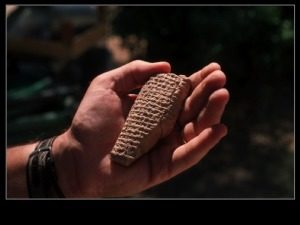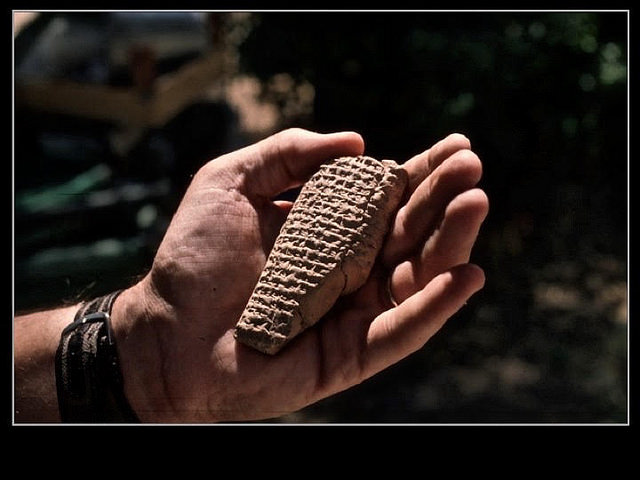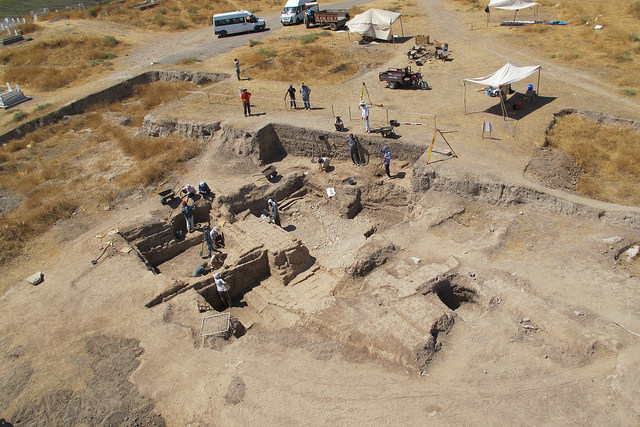
A team of archaeologists excavating at the site of Ziyaret Tepe in southeastern Turkey discovered a rare and unique cuneiform tablet — one that tells a story of frustration and desperation expressed by an ancient Assyrian official, providing a glimpse of conditions in the Assyrian Empire just before its collapse in the 7th century, B.C.
Recovered within the remains of what archaeologists have identified as an administrative complex, the clay tablet, small enough to be held in the palm of one’s hand, features, in cuneiform script, a letter written by Mannu-ki-libbali, who was a senior official of the Assyrian provincial capital of Tushan. Tushan was a 7th-century city that governed an area on the outskirts of the Assyrian Empire. In the letter, he responds to an order to assemble a unit of chariotry, but he explains that all of the skilled professionals he needed to accomplish it had already fled the city. He expresses his frustration and resignation with these final statements:
“How can I command? ….. Death will come out of it. No one will escape. I am done!”
“This letter is unparalleled,” writes the excavation leadership in an article published in Popular Archaeology Magazine. “It can only have been written as the front line drew close to Tushan and the infrastructure of the empire collapsed. As a first-hand account of Assyria in its death-throes it is unique.”
The administrative complex in which the tablet was found also yielded a remarkable archive of cuneiform tablets. Totaling 27, they were discovered in fragments on the floors of the rooms of the complex. “The contents of the tablets include movements of grain, the loan of a slave, lists of personnel, the resettlement of people and a census enumerating military officers and their agricultural holdings,” wrote the excavation leadership about the finds. “But the majority of the tablets deal with transactions of barley – deliveries from outlying farmsteads, loans and payments for rations.” They span the period from 614 BC to 611 BC — around the time of the the fall of Nineveh.
“This is the first time that Assyrian administrative texts from this period have ever been found,” stated dig directors Timothy Matney and John MacGinnis. The archive provides a window on the Assyrian world as the Babylonian king Nabopolassar was waging military campaigns against a disintegrating Assyrian empire.
Full-scale excavations at Ziyaret Tepe began in 2000 and lasted for 12 seasons. Located on the upper Tigris river abut 60 km east of Diyarbakir in southeastern Turkey, the site consists of a central mound 30 m high and the remains of a surrounding lower town about 30 hectares in area. The project, which was headed in the field by Prof. Timothy Matney of the University of Akron, Ohio, began with geophysical prospection and ceramic surface collection, and work at the site eventually yielded structural and artifact remains that evidenced a massive provincial capital that flourished for almost 300 years. According to written records, it was founded on a previously occupied site by the Assyrian king Ashurnasirpal II in 882 BC, but was then finally captured by the Babylonian king Nabopolassar in 611 BC. Archaeologists have uncovered a palace, an administrative complex, elite residences, and a military barracks at the site.
______________________________________
Letter ZTT 22, in which the writer Mannu-ki-libbali reports on the disintegration of the military infrastructure as the Assyrian empire collapsed. Ziyaret Tepe Archaeological Project
____________________________________________________
Aerial view of work in progress in the palace. Ziyaret Tepe Archaeological Project
__________________________________________________
An in-depth feature article about the excavations at Ziyaret Tepe, anciently known as Tushan, has been published in the Winter 2018 issue of Popular Archaeology Magazine.
___________________________________________________
Readers may also acquire a copy of the book, which relates much more detail about the excavations and the discoveries, at this website.
___________________________________________________
Receive 30 days free access to the popular new CuriosityStream lineup of documentaries on science, history, nature, and technology as a new Popular Archaeology premium subscriber.
___________________________________________
Travel and learn with Far Horizons.
______








